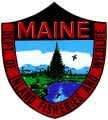Maine’s Moose Population Estimated at 76,000 After Aerial Survey

The Maine Department of Inland Fisheries and Wildlife now has its most accurate estimation of the state’s moose population thanks to a new aerial survey.
The Department currently estimates a population of 76,000 moose after using a double count technique the last two winters where two observers independently reported the number of moose observed while flying in a helicopter over northern and eastern Maine.
During the winter of 2010-2011, the Department used the technique, adapted from Quebec and New Brunswick where it was utilized to count deer, to survey Wild Management Districts (WMDs) 2, 3 and 6 with the help of the Maine Forest Service and funds from the Maine Outdoor Heritage Fund.
It was then decided that the aerial survey was far more accurate and efficient than previously used methods, including transect counts from fixed wing, line-track intercept techniques, a modified Gasaway survey and Forward Looking Infrared (FLIR).
“This new technique turned out to be a good and accurate way to look at moose across a big part of Maine, which we’ve never had the opportunity to do before,” said IFW Wildlife Biologist Lee Kantar. “It’s exciting to finally have the techniques to get so much information on moose in the state because the more we know about moose, the better able the department is to manage this magnificent resource for the people of Maine.”
Due to the right resources, equipment, help from the Maine Forest Service and funding from the federal Pittman-Robertson Fund, the Department was able to use the technique again this past winter and surveyed WMDs 1, 2, 4, 5, 8, 11, and 19, all of which are in the core moose range of the state.
The Department did not survey southern Maine because the low moose population numbers in that area would likely add little to the total statewide population.
During the aerial survey, one observer sits in the front of the helicopter while the other sits in the back on the same side.
The area being surveyed is broken down into a grid and transects are flown through the grid with both observers reporting numbers of moose seen on a transect line to a data recorder. The data recorder tells the observers when the transect starts and stops so they are counting the same area at the same time. Density estimates are calculated for each area based on mark-resight techniques.
httpv://youtu.be/WVqyRu6i16M
For more information, visit www.mefishwildlife.com.

